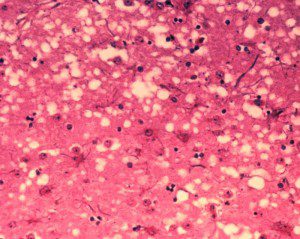

CJD is one of several neurological diseases known as transmissible spongiform encephalopathies (TSEs). These diseases are characterized by progressive mental and physical degeneration, and by the presence of microscopic holes in the cerebral cortex (hence ‘spongiform’). The disease was described in humans in the 1920s, but was not shown to be transmissible until Carleton Gajdusek‘s work on kuru in Papua New Guinea. The disease is caused by a novel infectious agent, called a prion by Stanley Prusiner. Prions do not contain nucleic acid; rather it is the misfolding of this protein that causes the disease. CJD is extremely rare, occuring in 1 per million humans per year.
There are three major kinds of CJD. In the sporadic form, which accounts for about 85% of all cases, a spontaneous mutations likely occurs in the prion gene. About 15% of the cases are caused by inherited autosomal dominant mutations; 30 different amino acid changes leading to the disease have been described to date. The remainder are transmitted iatrogenically: originating as a result of medical care. These include the use of contaminated growth hormone derived from human cadavers, implantation of contaminated dura mater grafts, using electroencephalographic electrodes, and surgery with contaminated instruments. Prions are probably not transmitted by aerosol or casual contact. However, they may be transmitted through contact with infected tissue or body fluids. A major problem is that prions are not inactivated by autoclaving or boiling.
Variant CJD (vCJD), first described in March 1996, affects younger patients (average age 29 years, versus 65 years for CJD), has a longer duration of illness (median of 14 months versus 4.5 months) and is linked to consumption of food from cattle with bovine spongiform encephalopathy (BSE), or mad cow disease. More than 184,000 cows with BSE, and over 162 causes of human vCJD have been identified in the United Kingdom.
My friend’s relative died of infectious CJD – but he had no history of a medical procedure or transplant consistent with transmission of the disease. He worked in a hospital in New York City – but as a physical therapist, and therefore would not have had direct contact with body fluids. His age – less than 50 – is the best evidence that he had vCJD. When and where he had eaten contaminated food will never be known – perhaps on a trip to Europe in the past 5 years. What we do know, however, is that cases of vCJD in the US are extremely rare – only three have ever been reported. Now there are four.

Do you think CJD/scrapie in anyway could be a possible viral infection? I read an article about cells with CJD/scrapie produce intracellular virus-like particles (Manuelidis et.al. PNAS, vol.104, no.6, 1965-1970)?
The majority of evidence points against CJD/scrapie being a viral
infection. The relative resistance to UV irradiation, for example, is
not consistent with the presence of a viral genome. More compelling
are the data obtained in animal models. Transmission of the scrapie
prion protein (PrPSc) between one species and another results in PrPSc
with the amino-acid sequence of the recipient, suggesting that
replication of the donor prion does not occur. Mice with PrP mutations
develop prion disease when transmission is prevented. I know that some
(Manuelidis et al) believe otherwise but all the data from most labs
are consistent with a protein-only disease.
this is a fantastic post. Just what I was looking for!
The donor egg is used when ovaries of the patient owing to the various reasons do not develop own eggs or at repeated unsuccessful attempts of methods of artificial fertilisation. The donor eggs also are used in medicine at risk of transfer to the child of hereditary illnesses.
CJD is a tragic disease. It is an example of nature going crazy.
CJD is a tragic disease. It is an example of nature going crazy.
 I always prefer the way Edward puts Jacob down in that calm way. You know, that “Do you understand that, mongrel?” and “I will break your jaw for her.”… just download something about that calm anger. This clip just seemed a TAD over the top. And I love how angry Bella is when Jacob kisses her. Download filmes @D0-W-n10@D_F1L RÂ